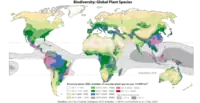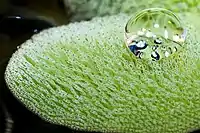Wilhelm Barthlott
Wilhelm Barthlott (born 1946 in Forst, Germany) is a German botanist and biomimetic materials scientist. His official botanical author citation is “Barthlott”.

Barthlott’s areas of specialization are biodiversity (Global distribution, assessment, and change in biodiversity) and Bionics/Biomimetics (in particular, superhydrophobic biological surfaces and their technical applications).
He is one of the pioneers in the field of biological and technical interfaces. Based on his systematic research on plant surfaces, he developed self-cleaning (Lotus Effect®) technical surfaces and technical surfaces, which permanently retain air under water (Salvinia® Effect). This led to a paradigm shift in particular areas of material science and facilitated the development of superhydrophobic biomimetic surfaces. His map of the global biodiversity distribution is the foundation for numerous research topics. Barthlott has been honored with many awards (e. g. the German Environment Award) and memberships in Academies (e. g. the German National Academy of Science Leopodina). A large red-flowering tropical shrub, Barthlottia madagascariensis and other plants are named after him.
Career
Wilhelm Barthlott descends from a French Huguenots family, which arrived with Jacques Barthelot in 1698 on the grounds of the Maulbronn monastery in Germany, where his mother’s family houses had existed already before 1520. He studied biology, physics, chemistry, and geography at the University of Heidelberg, Germany. He earned his doctorate in 1973 with a dissertation on systematics and biogeography of cacti investigated by means of scanning electron microscopy. He was appointed a professorship at the Free University of Berlin (Freie Universität Berlin) at the Institute for Systematic Botany and Plant Geography from 1982 to 1985. In 1985 he became the chair of systematic botany at the Botanical Institute of the University of Bonn and also the director of the Botanical Gardens. In 2003 he established the Nees Institute for Biodiversity of Plants as founding director. He was influential in the reorganization and expansion of both institutions.
Barthlott became emeritus in 2011, and continued as the head of the long-run research project “Biodiversität im Wandel” (“Biodiversity in Change”) until 2015, of the Academy of Sciences and Literature of Mainz. He co-founded with Walter Erdelen (UNESCO) the Biodiversity Network in Bonn BION in 2011, which was implemented by Wilhelm Barthlott and his successor Maximilian Weigend in 2013. He is investigating biological and technical superhydrophobic interfaces within the scope of his research projects in biomimetics.
Barthlott published one of the internationally most cited papers in plant science.[1] His work in materials science based on superhydrophobic Lotus Effect surfaces “can be considered the most famous inspiration from nature ….and has been widely applied…in our daily life and industrial productions”.[2]
Fields of work
Research in Biodiversity, classification and biogeography of plants
Barthlott has done extensive research focusing on Andean South America and Africa, in particular, on the taxonomy and morphology of cacti, orchids and bromeliads, applying scanning electron microscopy and molecular methods. Barthlott’s studies on carnivorous plants converged systematic and ecological research. These studies led to the discovery of the first protozoan trapping plant in the genus Genlisea. This plants also exhibit one of the highest evolutionary rates and has the smallest known genome among all flowering plants. The naming of Genlisea barthlottii pays tribute to his investigation in this regard. The shrub Barthlottia madagascariensis or the miniature Titan Arum Amorphophallus bartlottii and further species were named after him. Among his discoveries are the giant bromeliad Mezobromelia lyman-smithii or epiphytic cacti such as Rhipsalis juengeri, Pfeiffera miyagawae and Schlumbergera orssichiana. A complete list of plants can be found on the IPNI.
His biogeographic-ecological work was mostly conducted in South America, West Africa and Madagascar concentrating on arid regions,[3] epiphytes in tropical forest canopy,[4] as well as tropical inselbergs.[5] Additional works concentrated on the global mapping of biodiversity and its macroecological dependencies on the climate and other abiotic factors (Geodiversity), including migration and globalization.[6] His Biodiversity Distribution Map has been published in numerous textbooks and has been the foundation for many postgraduate studies. In the framework of the BMBF-BIOTA-AFRICA[7] project, which was led by him, the biodiversity patterns in Africa as a model continent were analyzed and potential impacts of climate change are investigated.
Bionics, Biomimetics, and Biological Interfaces
Wilhelm Barthlott was the first botanist using high resolution in scanning electron microscopy systematically in the research of biological surfaces since 1970. Most prominent among his results was the discovery of the self-cleaning effect of superhydrophobic micro- and nanostructured surfaces[8]), which were technically realized with the trademark Lotus Effect® from 1998 on,[9] resulting products are distributed worldwide. The patents and the trademark Lotus Effect® are owned by the company Sto-AG. Today about 2000 publications per year are based on his discovery, while the physics behind self-cleaning surfaces is still not completely understood.[10]
Currently, the research on biological interfaces and bionics is Barthlott’s central area of interest.[11][12][13] Ongoing research areas include air-retaining surfaces on the model of the floating fern Salvinia, which is based on a complex physical principle (Salvinia® Effect). Technical application of this effect is conceivable in shipping: By means of a reduction in frictional resistance (“passive air lubrication”), a 10% decrease in fuel consumption could potentially be achieved. Another application is the oil-water-separation by adsorption and transportation of oil on air retaining surfaces.[14]
 The first detailed world map of biodiversity of plants (first publisherd in Barthlott et al. 1996), shows the global distribution of plants
The first detailed world map of biodiversity of plants (first publisherd in Barthlott et al. 1996), shows the global distribution of plants_at_type_locality_SE_Madagascar_-_Foto_Charles_Rakotavao_(Tropicos%C2%AE)%252C_W._Barthlott%252C_Lotus.Salvinia.de.jpg.webp) Barthlottia madagascariensis, a large shrub from the foxglove family in Madagascar discovered in 1996
Barthlottia madagascariensis, a large shrub from the foxglove family in Madagascar discovered in 1996 The complex hairy surface of the Floating Fern Salvinia , related to the Lotus Effect, led Barthlott in 1994 to the discovery of the physically most complex Salvinia Effect (https://en.wikipedia.org/wiki/Salvinia_effect). It can be technically applied for passive air lubrication in ship hull or for oil-water-separation
The complex hairy surface of the Floating Fern Salvinia , related to the Lotus Effect, led Barthlott in 1994 to the discovery of the physically most complex Salvinia Effect (https://en.wikipedia.org/wiki/Salvinia_effect). It can be technically applied for passive air lubrication in ship hull or for oil-water-separation_%C2%A9_W._Barthlott%252C_Lotus-Salvinia.de.jpg.webp) This honey-spoon was at the Bonn University in 1994 the first technical product to demonstrate the self cleaning effect of superhydrophobic surfaces after the discovery of the Lotus-Effect in 1977
This honey-spoon was at the Bonn University in 1994 the first technical product to demonstrate the self cleaning effect of superhydrophobic surfaces after the discovery of the Lotus-Effect in 1977
Honors and awards
- 1990 Member of the Academy of Science and Literature in Mainz[15]
- 1991 “Foreign Member” of the Linnean Society of London.
- 1997 Member of the Academy of Science of North Rhine-Westphalia Düsseldorf
- 1997 Karl-Heinz-Beckurts Award
- 1998 Nomination for the German Future Innovation Award (Deutscher Zukunftspreis des Bundespräsidenten)
- 1998 Order of Andrès Bello of President Rafael Caldera of the Republic of Venezuela
- 1999 Member of the German National Academy of Sciences, Leopoldina[16]
- 1999 Philip Morris Award
- 1999 German Environment Award (Deutscher Umweltpreis)[17]
- 2001 Treviranus Medal of the Association of German Biologists (Verband Deutscher Biologen)
- 2001 GlobArt Award (Austria)
- 2002 Cactus d’Or (Monaco)
- 2004 Scientist in Residence of the University Duisburg-Essen
- 2005 Innovation Award of the German Federal Ministry of Education and Research
- 2006 Award of the university competition “Ingenious Inventors” (Hochschulwettbewerb Patente Erfinder) of North Rhine-Westphalia
- 2007 Maecenas medal of the University of Bonn
- 2010 - 2014 Director of the Board of the International Society of Bionic Engineering (ISBE), Beijing (China)
Publications
Wilhelm Barthlott’s publications comprise more than 470 titles, among them are numerous books. A complete directory can be found at Wilhelm Barthlott Google Scholar Citations or www.lotus-salvinia.de
Selected works
Gandyra D, et al. (2020): Air retention under Water by the floating fern Salvinia: the crucial role of a trapped air layer as a pneumatic spring. - Nano-Micro Small (Wiley-VCH) https://onlinelibrary.wiley.com/doi/full/10.1002/smll.202003425
Barthlott, W. (2020): Plants and nature in Bible and Quran - how respect for nature connects us. - pp. 233-244 in Proceed. Conf. “Science and Actions for Species Protection: Noah´s Arks for the 21st Century, May 2019, Eds. J.von Braun et al.. – The Pontifical Academy of Sciences PAS, Vatican City
Barthlott W et al. (2020): Adsorption and transport of oil on biological and biomimetic superhydrophobic surfaces – a novel technique for oil-water separation, Phil Trans. Roy. Soc. A. https://royalsocietypublishing.org/doi/10.1098/rsta.2019.0447
Mail, M. et al. (2019): Air retaining grids – A novel technology to maintain stable air layers under water for drag reduction. – Phil. Trans. Roy.Soc. A, - https://doi.org/10.1098/rsta.2019.0126
Schulte, A.J. et al. (2019): Ultraviolet patterns of flowers revealed in polymer replica caused by surface architecture. . – Beilstein J. Nanotechnology 10, 459-466, https://www.beilstein-journals.org/s/xaJQ37HqZR
Mail, M. et al. (2019): A new bioinspired method for pressure and flow sensing based on the underwater air retaining surfaces of the backswimmer Notonecta – Beilstein J. Nanotechnology 9, 3039-3047, Doi10.3762/bjnano.9.282 - https://www.beilstein-journals.org/bjnano/content/pdf/2190-4286-9-282.pdf?m=y
Busch, J.M. et al. (2018): Bionics and Green Technology in Maritime Shipping: An Assessment of the Effect of Salvinia Air-Layer Hull Coatings for Drag and Fuel Reduction - Phil. Trans. Royal Soc. A, (Vol. 377: “Bioinspired Materials and Surfaces for Green Science and Technology”), London - DOI 10.1098/rsta.2018.0263
Zeisler-Diehl, V. et al. (2018): Plant cuticular waxes: composition, function and interactions with microorganisms - Springer Handbook of Hydrocarbons and Lipid Microbiology Series. Hydrocarbons, Oils and Lipids: Diversity, Origin, Chemistry and Fate. - Doi:10.1007/978-3-319-54529-5_7-1
Da, S. S. et al. (2018) – Plant Biodiversity Patterns along a climatic gradient and across protected areas in West Africa – African Journal of Ecology, https://dx.doi.org/10.1111/aje.12517
Moosmann, M. et al. (2017): Air–water interface of submerged superhydrophobic surfaces imaged by atomic force microscopy – Beilstein J. Nanotechnology 8: 1671-1679 https://www.beilstein-journals.org/bjnano/articles/8/167.
Barthlott, W. et al. (2017): Plant Surfaces: Structures and Functions for Biomimetic Innovations. – Nano-Micro Letters,9:23, Springer http://rdcu.be/ohK3
Barthlott, W. et al. (2016): Bionics and Biodiversity – Bio-inspired Technical Innovation for a Sustainable Future. – in: “Biomimetic Research for Architecture: Biologically-Inspired Systems ”, pp. 11–55, (Eds.: J. Knippers et al.), Springer Publishers. DOI: 10.1007/978-3-319-46374-2
Barthlott, W. et al. (2016): Pflanzen der Heiligen Bücher Bibel und Koran - النباتات في الكتب السماوية: الإنجيل و القرآن. BfN Skripten No. 448, 106 S.,[Download PDF]
Barthlott, W. et al. (2016): Superhydrophobic hierarchically structured surfaces in biology: evolution, structural principles and biomimetic applications.- Phil. Trans. R. Soc. A. DOI:10.1098/rsta.2016.0191
Barthlott, W. et al. (2015): Biogeography and Biodiversity of Cacti. - Schumannia 7, pp. 1–205, ISSN 1437-2517 [Download]
Barthlott, W. et al. (2014): Orchid seed diversity: A scanning electron microscopy survey. – Englera 32, pp. 1–244.[Download]
Yan, Y. Y., Gao, N. & W. Barthlott (2011): Mimicking natural superhydrophobic surfaces and grasping the wetting process: A review on superhydrophobic surfaces. pp. 80–105. Adv.Colloid Interface Science, DOI: 10.1016/j.cis.2011.08.005
Sommer, J. H. et al. (2010): Projected impacts of climate change on regional capacities for global plant species richness. Proc. Royal Soc. DOI: 10.1098/rspb.2010.0120
Kier, G. et al. (2009): A global assessment of endemism and species richness across island and mainland regions. PNAS 106 (23):DOI: 10.1073/pnas.0810306106
Barthlott, W. et al. (2009): A torch in the rainforest: thermogenesis of the Titan arum (Amorphophallus titanum). Plant Biol. 11 (4): 499-505 DOI: 10.1111/j.1438-8677.2008.00147.x
Barthlott, W. et al. (2007): The curious world of carnivorous plants. 244 pp., Timber Press
Greilhuber, J. et al. (2006): Smallest angiosperm genomes found in Lentibulariaceae, with chromosomes of bacterial size. Plant Biol. 8: 770-777 DOI:10.1055/s-2006-924101
Barthlott, W. et al. (2005): Global centres of vascular plant diversity. Nova Acta Leopoldina 92 (342): 61-83
Borsch, T. et al. (2003): Noncoding plastid trnT-trnF sequences reveal a well resolved phylogeny of basal angiosperms. J. Evol. Biol. 16: 1-19 DOI: 10.1046/j.1420-9101.2003.00577.x
Barthlott, W. & M. Winiger (eds.) (2001): Biodiversity. A challenge for development research and policy. 429 pp., Springer Publishers DOI:10.1007/978-3-662-06071-1
Porembski, S. & W. Barthlott (eds.) (2000): Inselbergs: biotic diversity of isolated rock outcrops in tropical and temperate regions. 528 pp., Springer Publishers DOI:10.1007/978-3-642-59773-2
Barthlott, W. et al. (1998): First protozoa-trapping plant found. Nature 392: 447 DOI: 10.1038/33037
Barthlott, W. & C. Neinhuis (1997): Purity of the sacred lotus, or escape from contamination in biological surfaces. Planta 202: 1-8 DOI: 10.1007/s004250050096
Barthlott, W. et al. (1996): Global distribution of species diversity in vascular plants: towards a world map of phytodiversity. Erdkunde 50: 317-327 DOI: 10.1007/s004250050096
Wagner, T. et al. (1996): Wettability and contaminability of insect wings as a function of their surface sculptures. Acta Zoologica 77 (3): 213-225 DOI: 10.1111/j.1463-6395.1996.tb01265.x
Burr, B. et al. (1995): Untersuchungen zur Ultraviolettreflexion von Angiospermenblüten. III. Dilleniidae und Asteridae. 186 pp , Akad. Wiss. Lit. Mainz. F. Steiner Verlag, Stuttgart,.[Download PDF]
Noga, G. et al. (1991): Quantitative evaluation of epicuticular wax alterations as induced by surfactant treatment. Angew. Bot. 65: 239-252
Barthlott, W. & E. Wollenweber (1981): Zur Feinstruktur, Chemie und taxonomischen Signifikanz epicuticularer Wachse und ähnlicher Sekrete. 67 S., Akad. Wiss. Lit. Mainz. F. Steiner Verlag, Stuttgart,[Download PDF]
Barthlott, W. (1979): Cacti. 249 S., Stanley Thornes Publishers, London
Barthlott, W. & N. Ehler (1977): Raster-Elektronenmikroskopie der Epidermis-Oberflächen von Spermatophyten. 105 pp ., Akad. Wiss. Lit. Mainz. F. Steiner Verlag, Stuttgart,[Download PDF]
References
The information in this article is mostly derived from established sources, and the following sources are cited:
- White, P. J, (2018): Citation classics in Plant Science since 1992. - Botany One / Annals of Botany 23rd Jan. 2018: https://www.botany.one/2018/01/citation-classics-plant-sciences-since-1992/
- Yu, Sasic, Liu et al. (2020): Nature-Inspired self-cleaning surfaces: mechanism, modelling, and manufacturing. - Chemical Engineering Research and Design (Elsevier), Vol. 115 p. 48-65. https://www.sciencedirect.com/science/article/abs/pii/S0263876219305702
- Barthlott, W. et al. (2015): Biogeography and Biodiversity of Cacti. - Schumannia 7, pp. 1-205, ISSN 1437-2517
- Köster, N. et al. (2011): Effect of host tree traits on epiphyte diversity in natural and anthropogenic habitats in Ecuador. Biotropica 43 (6): 685-694, DOI:10.1111/j.1744-7429.2011.00759.x
- Porembski, S. & W. Barthlott (eds.) (2000): Inselbergs: biotic diversity of isolated rock outcrops in tropical and temperate regions. 528 S., Springer Publishers DOI:10.1007/978-3-642-59773-2
- Barthlott, W. & Rafiqpoor, M.D. (2016): Biodiversität im Wandel – Globale Muster der Artenvielfalt. In: Lozán et al.: Warnsignal Klima: Die Biodiversität, pp. 44-50. In Kooperation mit GEO- Verlag. Wissenschaftliche Auswertungen. www.warnsignal-klima.de.
- Eintrag auf der Seite des BMBF-BIOTA AFRIKA-Projektes
- Baeyer, H, C, von, (2000); The Lotus Effect. - The Sciences: J. New York Academy of Sciences 12-15, January 2000
- Forbes, P. (2006) The Gecko´s Foot. – Fourth Estate, HarperCollins, New York, 272 pp.
- Geyer, F. et al (2020): When and how self-cleaning of superhydrophobic surfaces works. - ScienceAdvances 6, 3, https://advances.sciencemag.org/content/6/3/eaaw9727?intcmp=trendmd-adv
- Barthlott, W., Mail, M. & C. Neinhuis, (2016) Superhydrophobic hierarchically structured surfaces in biology: evolution, structural principles and biomimetic applications.- Phil. Trans. R. Soc. A.DOI:10.1098/rsta.2016.0191
- Barthlott, W., Rafiqpoor, M.D. & W.R. Erdelen, (2016) Bionics and Biodiversity – Bio-inspired Technical Innovation for a Sustainable Future. – in: “Biomimetic Research: Biological Design and Integrative Structures”, pp. 11-55, (Eds.: J. Knippers et al.), Springer Publishers. DOI: 10.1007/978-3-319-46374-2
- Barthlott, W. et al. 2017: Plant Surfaces: Structures and Functions for Biomimetic Innovations. – Nano-Micro Letters, 9:23, doi:10.1007/s40820-016-0125-1
- Barthlott W et al. (2020): Adsorption and transport of oil on biological and biomimetic superhydrophobic surfaces – a novel technique for oil-water separation - 15 pp., Phil Trans. Roy. Soc. A. https://royalsocietypublishing.org/doi/10.1098/rsta.2019.0447
- Mitgliedereintrag auf der Website der Akademie der Wissenschaft und Literatur Mainz
- Mitgliedseintrag von Prof. Dr. Wilhelm Barthlott (mit Bild und CV) bei der Deutschen Akademie der Naturforscher Leopoldina, abgerufen am 29. Juni 2016.
- Eintrag im Preisträger-Archiv der DBU
Supporting Documentation
- Curriculum Vitae at www.lotus-salvinia.de
- A complete publication list with PDFs can be found at www.lotus-salvinia.de or in Google Scholar Citations Wilhelm Barthlott
External links
- Literatur von und über Wilhelm Barthlott im Katalog der Deutschen Nationalbibliothek
- Autoreintrag und Liste der beschriebenen Pflanzennamen für Wilhelm Barthlott beim IPNI
- www.lotus-salvinia.de
- Google Scholar Citations Wilhelm Barthlott
- ResearchGate Wilhelm Barthlott
- Lotus-Effekt
- Salvinia-Effekt
- "Prof.Dr. Wilhelm Barthlott: 99 seconds for the future of biodiversity" „Der Lotus-Effekt“ by Philip Morris Stiftung 1998
- "Lufthaltende Schiffsbeschichtungen nach biologischem Vorbild zur Reibungsreduktion" Fraunhofer UMSICHT
- Nees-Institut für Biodiversität der Rheinischen Friedrich-Wilhelms-Universität Bonn
- Botanische Gärten der Rheinischen Friedrich-Wilhelms-Universität Bonn (http://www.botgart.uni-bonn.de)
- BMBF-BIOTA AFRIKA-Projekt (http://www.biota-africa.org)
- BION Bonn (http://www.bion-bonn.org/de)
- Akademie der Wissenschaft und der Literatur, Mainz
- Bundesamt für Naturschutz (http://www.bfn.de/religionen_und_natur.html)